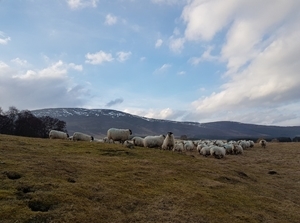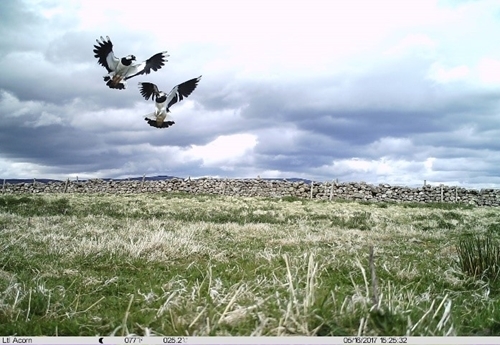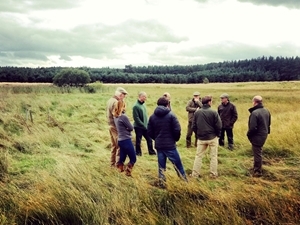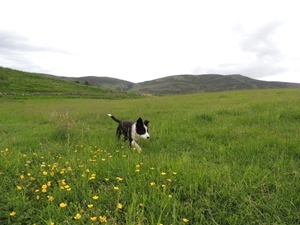There are three main grassland types at Auchnerran – permanent grazing, rough grazing and rush dominated pasture, and rotational grassland.
Permanent grazing
 The undulating fields to the west of the farm are permanent grassland. Some of these permanent pastures receive lime, fertiliser and sprays to enhance pasture growth. As grazing pasture is limited on the farm, we require high quality grass to feed our expanding sheep flock.
The undulating fields to the west of the farm are permanent grassland. Some of these permanent pastures receive lime, fertiliser and sprays to enhance pasture growth. As grazing pasture is limited on the farm, we require high quality grass to feed our expanding sheep flock.
These grasslands may appear quite uninteresting but their dense root mat and the organic litter that has built up in the soil means they support a huge range of invertebrates, both above and below the surface. As these fields have been relatively undisturbed, they provide adequate breeding and nesting grounds for ground-nesting birds, particularly lapwings. In addition, small numbers of grassland fungi, including wax caps, have been observed on these slopes, indicating a diverse community of life still waiting to be explored.

Rough grazing and rush-dominated pastures
 A botanical analysis can be used to define the difference between permanent and rough grazing. Where the sward is dominated by recently sown plants (e.g. rye grass, clover, timothy) the area is regarded as permanent grazing, whereas when it is predominantly natural species such as Molinia it is classified as rough grazing. Some of the rough grazing at Auchnerran is dominated (>50%) by rushes.
A botanical analysis can be used to define the difference between permanent and rough grazing. Where the sward is dominated by recently sown plants (e.g. rye grass, clover, timothy) the area is regarded as permanent grazing, whereas when it is predominantly natural species such as Molinia it is classified as rough grazing. Some of the rough grazing at Auchnerran is dominated (>50%) by rushes.
The rough grazing on the southern higher slopes are dry swards which can have high proportions of heath rich in bumblebees, whereas on the eastern lower areas the grazing is very wet fen-like marsh habitat which is home to snipe, curlew and reed buntings.
Rough grazing presents some of the most important biodiversity benefits and management challenges.
These habitats need to be managed to prevent them becoming too dense and impenetrable, which can be achieved through careful grazing and cutting adhering to the Good Agricultural and Environmental Condition (GAEC) regulations. Now that the farm has entered the Agri-Environment Climate Scheme (AECS), the capacity to graze these rough areas will be greatly increased due to the improvement of stock fencing.
Rotational grassland

Around 10% of the farm is arable land, located to the north and eastern sides of the farm. Most of this land is used to grow grass. Grass leys are cut for silage which is a critical part of the sheep flock’s overwinter food supply. Between November and May the 1,000 ewes (breeding female sheep), 200 hoggs (this year’s female lambs) and the 28 tups (breeding male sheep) will eat around 700 tons of silage.
Grassland Management
- Traditionally, temporary grass leys are replaced every five years by ploughing which takes place in spring.
- New mixtures of grass and herbs are drilled into ploughed land, then called the ‘re-seed’.
- The mixtures can be made to yield large amounts of leafy biomass, be mixed with nitrogen-fixing clover, or include species that support pollinators, or are good for the sheep’s parasite resistance when grazed.
- The grass is cut for forage once a year and round-baled as one-tonne bales of silage.
- The sheep then get ‘back end grazing’ from the regenerating sward from October.
These fields are used by wading birds, brown hares, migratory geese, rabbits and roe deer. But the process of supporting the grass as it establishes in the year of re-seeding, and the years after, can mean intensive activity if maximum grass growth and quality are the aim. The grass may need to be limed, fertilised, sprayed against weeds and rolled, as well as cut. Many of these management operations take place when ground-nesting birds, such as lapwing, curlew and oystercatcher, as well as brown hares have young. It is important to consider each progressive stage of the breeding season for these animals so that agricultural practices can be carried out with minimal impact to wildlife.
We will be developing ideas for
- Improving forage quality while balancing wildlife requirements.
- Sensitively and safely carrying out rolling and cutting of grass fields.
- Integrating pollinator and wildlife-friendly mixes into the grass.
- Revisiting whether the concept of conservation headlands can be made to work in grass fields.
- Direct-drilling of re-seed pastures.
- Reduced ploughing regimes: grass 6-7 years, long term grass, 10-12 years.
- Topping delayed till late June/beginning July.
- Studying how ‘stitching-in’ grass and herb seed might reduce the need to plough (saving fuel, reducing organic matter and soil biodiversity loss whilst making soil less vulnerable to erosion).
- Measuring the impact of rabbit grazing on reducing grass productivity and spreading disease.